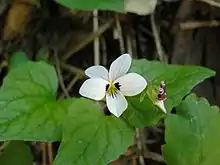| Viola ocellata | |
|---|---|
 | |
| Scientific classification | |
| Kingdom: | Plantae |
| Clade: | Tracheophytes |
| Clade: | Angiosperms |
| Clade: | Eudicots |
| Clade: | Rosids |
| Order: | Malpighiales |
| Family: | Violaceae |
| Genus: | Viola |
| Species: | V. ocellata |
| Binomial name | |
| Viola ocellata | |
Viola ocellata is a species of violet known by the common names pinto violet,[1] two-eyed violet,[2] and western heart's ease.[3] It is native to southern Oregon and northern and central California, where it occurs in the coastal foothills and mountain ranges. It sometimes grows in serpentine soils[4] and in quicksilver mines.[5]
Description
This rhizomatous herb produces a hairy erect or decumbent stem measuring 5 to 37 centimetres (2.0 to 14.6 in) long. The leaves have heart-shaped or roughly lance-shaped blades borne on petioles a few centimeters long. A solitary flower is borne on a long, upright stem. It has five white petals with yellow bases, the lowest three veined with purple and the two lateral ones with purple eyespots. The inside of the flower has long hairs. The outer surfaces, at least of the two upper petals, is usually stained dark red or purple. It capsules are spherical and are 5–11 millimetres (0.20–0.43 in) long while its peduncles are puberulent and are 1–10 centimetres (0.39–3.94 in) long. The seeds of the plant are brownish-purple in colour and are 2 millimetres (0.079 in) long. The rootstocks are often long and stolon-like.[6]
The species is a host plant of the butterfly Boloria epithore.[7]
References
- ↑ "Oregon Flora Image Project". Retrieved May 21, 2018.
- ↑ Theodore F. Niehaus; Charles L. Ripper (1976). A Field Guide to Pacific States Wildflowers: Washington, Oregon, California and adjacent areas. Peterson Field Guide. p. 52. ISBN 0-395-21624-9.
- ↑ Linda H. Beidleman; Eugene N. Kozloff (2014) [2003]. Plants of the San Francisco Bay Region: Mendocino to Monterey. University of California Press. p. 314. ISBN 978-0-520-27859-2.
- ↑ Arthur R. Kruckeberg (1984). California Serpentines: Flora, Vegetation, Geology, Soils, and Management Problems. Vol. 78. University of California Press. p. 158. ISBN 0-520-09701-7. LCCN 83-18237.
- ↑ Reports of Explorations and Surveys to Ascertain the Most Practical and Economical Route for a Railroad from the Mississippi River to the Pacific Ocean (Report). Vol. 4. 1856. p. 68.
- ↑ Bulletin - Vermont Agricultural Experiment Station, issues 222-225. 1921. p. 141.
- ↑ James A. Scott (1986). The Butterflies of North America: A Natural History and Field Guide. Stanford University Press. p. 320. ISBN 9780804720137.
External links